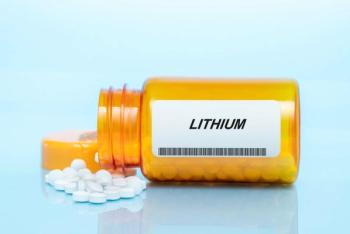
Researchers Present New Data on Parkinson Therapies
Even as data mount in support of rasagiline (Agilect) as an alternative therapy for the motor symptoms of Parkinson disease (PD), additional research on the next generation of dopamine agonists suggests that this class of drugs will not be dispensed with any time soon. Findings presented in April at the annual meeting of the American Academy of Neurology (AAN) linked symptom improvement not only to the monoamine oxidase type B inhibitor but also to several nonergoline agonists, including 2 that target receptors other than D1 and D2 and are delivered transdermally.
Even as data mount in support of rasagiline (Agilect) as an alternative therapy for the motor symptoms of Parkinson disease (PD), additional research on the next generation of dopamine agonists suggests that this class of drugs will not be dispensed with any time soon. Findings presented in April at the annual meeting of the American Academy of Neurology (AAN) linked symptom improvement not only to the monoamine oxidase type B inhibitor but also to several nonergoline agonists, including 2 that target receptors other than D1 and D2 and are delivered transdermally.
Rasagiline trials--with catchy acronyms such as PRESTO, LARGO, and TEMPO--and extensions of those trials peppered the medical literature and meeting syllabi this spring as the drug's manufacturer, Teva Neuroscience, waited for an FDA follow-up on a letter for approval issued last summer. Most recently, at the AAN meeting, a platform presentation (47.005)1 and a poster presentation (2.104)1 detailed findings from an extension of the TVP-1012 in Early Monotherapy for Parkinson disease Outpatients (TEMPO) trial conducted by the Parkinson Study Group.
UPBEAT TEMPO
The original 26-week TEMPO study, published in the December 2002 issue of Archives of Neurology,2 found that patients with early-stage PD who randomly received placebo treatment were significantly more likely to experience more than 3 units of functional deterioration on the Total Unified Parkinson's Disease Rating Scale (UPDRS) than those who were treated with either 1 or 2 mg/d of rasagiline monotherapy. A second phase of that trial, reported in the Archives of Neurology in April 2004,3 found that UPDRS-measured function declined further over a 12-month period in patients whose rasagiline treatment was delayed 6 months than in those who had been treated for the entire year.
After that 12-month double-blind period, 306 patients from the TEMPO trial were subsequently converted to an open-label study in which all patients received 1 mg/d of rasagiline and additional dopaminergic therapy as needed. Of the 266 patients who completed 2 years of study, 46% were still "adequately controlled" by rasagiline monotherapy, according to Mark Lew, MD, professor and director of the division for movement disorders at the University of Southern California's Keck School of Medicine, who presented the group's results at the AAN meeting. Annual functional deterioration was approximately 2 to 3 UPDRS units (from a baseline level of 26.1), Lew said. This compares favorably with previously published annual deterioration rates of 8 to 14 units in patients treated with placebo.2,4-6
Long-term follow-up results from the same group, presented as a poster at the AAN meeting, also confirmed the 1-year findings that favored early rasagiline treatment. In 177 patients from the original double-blind study who had been converted to the open-label study and monitored for at least 4.5 years, those who received early treatment experienced 2.42 fewer UPDRS units of functional decline over time than those whose treatment was initially delayed by 6 months.
The Lasting effect in Adjunct therapy with Rasagiline Given Once daily (LARGO) trial, which was reported in the March issue of Lancet,7 randomly treated 687 outpatients who were receiving levodopa with concurrent rasagiline, 1 mg/d; entacapone, 200 mg, with each levodopa dose; or placebo. After 18 weeks, patients in both treatment groups fared significantly better than did those in the placebo group in hours of daily off-time, clinical global improvement scores, and UPDRS scores (Table 1). In the February issue of Archives of Neurology,8 the Parkinson Study Group had reported similar significant differences between patients receiving 1 or 0.5 mg/d of rasagiline as an adjunct to levodopa and those from a placebo group (See Applied Neurology, "New Drug in Arsenal for Parkinson Disease on the Near Horizon," April 2005, page 14.)
AGONIST ANALYSIS
Meanwhile, in other sectors of the research community, dopamine agonists have been holding their own. A 10-year follow-up study presented at the AAN meeting (47.006)1 suggests that the nonergoline D2 agonist ropinirole (Requip, GlaxoSmithKline), indicated for treatment of PD, can be an effective long-term therapy for slowing the development of dyskinesia.
Members of the 056 Study Group had previously compared ropinirole with levodopa over a 5-year period in 268 patients with early-stage PD and found that initial treatment with ropinirole was associated with a lower cumulative incidence of dyskinesia and a longer time to dyskinesia compared with levodopa.9
Of the 130 patients who completed the 5-year trial, 69 were retained for another 5 years of follow-up, during which they could receive any treatment; 48 actually completed the 10-year span. Despite the small number of patients available for long-term follow-up, the researchers nonetheless found significant differences between groups in terms of incidence of dyskinesia, time to development of dyskinesia, and incidence of disabling dyskinesia (Table 2).
At the end of the 10 years, none of the 28 patients who had initially received ropinirole were currently receiving ropinirole monotherapy; 20 were receiving a combination of ropinirole and levodopa, said Amos D. Korczyn, MD, a professor of neurology at the Sackler School of Medicine in Tel Aviv, Israel, who presented his group's results at the AAN meeting. By comparison, 4 of the 20 patients who had initially received levodopa were still on levodopa monotherapy at the study's end; 5 were receiving a combination of ropinirole and levodopa; and 7 were receiving a combination of levodopa and other therapy. None of the patients who had initially received ropinirole developed disabling dyskinesia until after they received supplementary levodopa therapy, Korczyn said.
A PAIR TO COMPARE
Head-to-head comparisons of PD therapies are in short supply. In extending the Parkinson-CONTROL study10 from 12 to 24 months, however, European researchers not only documented the long-term efficacy of piribedil (Trivastal, Servier) in combination with levodopa, but did so in the context of a comparison with a more conventional dopamine agonist.
The original multicenter study randomly assigned 425 patients with idiopathic PD to 150 mg/d of piribedil (which targets both D2 and D3 receptors as a dopamine agonist and targets a2-adrenoreceptors as an antagonist) or 25 mg/d of the dopamine agonist bromocriptine. Patients in both groups also received daily levodopa therapy as needed. The 2 therapies were associated with similar levels of motor improvement, but patients in the piribedil group were slightly more likely to achieve a 30% improvement. In addition, at the end of the 12 months, the average daily levodopa dosage had increased by a smaller amount in patients receiving piribedil than in those receiving bromocriptine (7.6 ± 122 mg/d vs 16.6 ± 91 mg/d).
In observing 52 of the original study subjects for an additional 12 months, the researchers saw these trends continue. The findings, presented at the AAN meeting (2.106),1 show similar levels of motor improvement (27.5 6 10 units for piribedil vs 27.9 6 9.9 units for bromocriptine) and significantly lower levels of levodopa use in the piribedil group than in the bromocriptine group (Table 3).
PATCHWORK
The next of the new generation of dopamine agonists to hit the market may be unique, with a formula that targets 3 dopamine receptors and is delivered transdermally. The FDA accepted a new drug application at the end of March for rotigotine (Neupro); the drug's manufacturer, Schwarz Pharma, also submitted an application in October to the European Medical Agency.
The latest research on the product, presented at the AAN meeting (2.103),1 extended a previously presented 6-month double-blind study to include an additional 6 months of open-label treatment and found that the functional improvement seen initially was maintained in the treated patients. The original study, presented in June 2004 at the International Congress of Parkinson's Disease and Movement Disorders,11 randomly assigned 277 patients with early-stage PD to receive rotigotine or placebo; dose levels in the treatment group were titrated to each patient's optimal level of 4.5, 9, or 13.5 mg/d delivered via a 30-cm2 transdermal patch. More than 90% of patients were treated at the 13.5-mg/d dosage. After 6 months, researchers reported significant motor improvement (5.3 UPDRS units) in those receiving rotigotine compared with those receiving placebo. In addition, 43% of treated patients experienced an improvement in UPDRS score of more than 20%, compared with 19% of patients who received placebo.
Six months after patients from both groups were converted to open-label rotigotine treatment, the researchers found that the difference in motor improvement trend had been maintained. Patients who had initially received rotigotine therapy demonstrated 4.1 units of improvement after 12 months, whereas those who began receiving patch therapy 6 months later demonstrated 2.4 units of improvement. Use of concomitant antiparkinson therapy did not differ significantly between the 2 groups.
COMING OF AGE
The most important issue facing dopamine agonist researchers in the future may not be whether a therapy is effective, but rather in which patients it is effective. Concern about the tolerability of dopamine agonists in very old patients has already been voiced by researchers from the University of Miami, who reported that therapeutic doses of the drugs were well tolerated in just 46% of 69 patients older than 80 years.12 Toleration--or therapeutic success--was defined as maintenance on the agonist for at least 6 months. The highest success rate (56%) was seen with bromocriptine, the lowest (31%) with ropinirole.
The concept was revisited by researchers from the Parkinson's Disease and Movement Disorders Center of Boca Raton, Fla, who identified 132 patients older than 80 years who had been treated with dopamine agonists (2.105)1 from the Ali Project database. The researchers found that the elderly patients who received dopamine agonists had lower UPDRS scores, improved postural reflexes, decreased use of levodopa, and fewer motor fluctuations. Once- or twice-daily dosing was better tolerated than more frequent dosing, and slow titration helped limit numbers of adverse events and improve tolerability.
The next generation of dopamine agonists may provide different degrees of efficacy in the elderly--or in other subgroups of patients with PD. Those, it is hoped, will be topics of discussion at future AAN meetings. *
REFERENCES
1. 57th Annual Meeting Program. Neurology. 2005:64(suppl 1).
2. Parkinson Study Group. A controlled trial of rasagiline in early Parkinson disease: the TEMPO Study. Arch Neurol. 2002;59:1937-1943.
3. Parkinson Study Group. A controlled, randomized, delayed-start study of rasagiline in early Parkinson disease. Arch Neurol. 2004;61:561-566.
4. Parkinson Study Group. Effects of tocopherol and deprenyl on the progression of disability in early Parkinson's disease. N Engl J Med. 1993;328:176-183.
5. Parkinson Study Group. Effect of lazabemide on the progression of disability in early Parkinson's disease. Ann Neurol. 1996;40:99-107.
6. Shults CW, Oakes D, Kieburtz K, et al. Effects of coenzyme Q10 in early Parkinson disease: evidence of slowing of the functional decline. Arch Neurol. 2002;59:1541-1550.
7. Rascol O, Brooks DJ, Melamed E, et al. Rasagiline as an adjunct to levodopa in patients with Parkinson's disease and motor fluctuations (LARGO, Lasting effect in Adjunct therapy with Rasagiline Given Once daily, study): a randomised, double-blind, parallel-group trial. Lancet. 2005;365:947-954.
8. Parkinson Study Group. A randomized placebo-controlled trial of rasagiline in levodopa-treated patients with Parkinson disease and motor fluctuations: the PRESTO study. Arch Neurol. 2005;62:241-248.
9. Rascol O, Brooks DJ, Korczyn AD, et al. A five-year study of the incidence of dyskinesia in patients with early Parkinson's disease who were treated with ropinirole or levodopa. N Engl J Med. 056 Study Group. 2000;342:1484-1491.
10. Cesaro P, Aguilar M, Caldas AC, et al. The Parkinson-control study: a multicentre trial comparing piribedil (150 mg/day) to bromocriptine (25 mg/day) in early combination with L-dopa in Parkinson's disease. Eur J Neurol. 2003;10(suppl 1):231-233.
11. Watts RL, Wendt J, Nausieda PL, et al. Efficacy, safety, and tolerability of the rotigotine transdermal patch in patients with early-stage, idiopathic Parkinson's disease: a multicenter, multinational, randomized, double-blind, placebo-controlled trial. Mov Disord. 2004;19(suppl 9):S258.
12. Shulman LM, Minagar A, Rabinstein A, Weiner WJ. The use of dopamine agonists in very elderly patients with Parkinson's disease. Mov Disord. 2000;15:664-668.
Newsletter
Receive trusted psychiatric news, expert analysis, and clinical insights — subscribe today to support your practice and your patients.

















